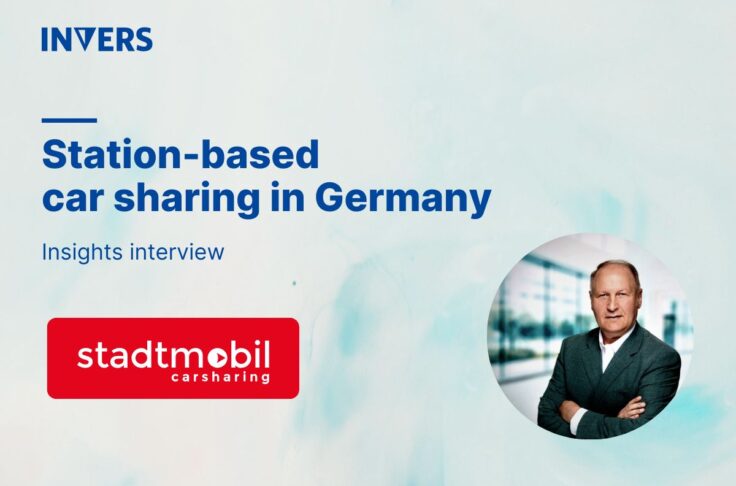Mobility as a Service: Lessons from Trafi
Summary
In this “Lessons from” edition, we dive into MaaS and talk with Martynas Gudonavičius, CEO at Trafi – the world’s leading Mobility as a Service (MaaS) platform company.
MaaS is facilitating the shift towards multi-modal trips by bringing together public transit, carsharing, and micromobility options all under one roof. For consumers, this means they only need to open one app to check schedules and availabilities, plan the trip, and book tickets.

Trafi works with cities, operators, and employers to enable them to provide MaaS and connect different options within the transportation network together. By working closely with stakeholders, Trafi has overcome the challenges of adoption and ensures they have a reliable platform, so people can continue to rely on MaaS instead of a private vehicle.
Let’s dive into the interview to learn how Trafi works towards its mission to empower cities’ urban transportation with technology and know-how, and encourage citizens to use more sustainable modes of transportation by accessing all services into one single platform. Trafi is currently live in 4 continents around the world and 7 cities.
What makes Trafi different from other MaaS platform providers?
Our collaboration empowers cities to leverage Mobility as a Service data to improve public transport, walking, and cycling infrastructure (e.g. Vilnius public transport authority for walk paths, World Bank for recommendations to Indonesia).
Since day one we were public transport first and sought to provide the highest quality public transport information. Thus, we even developed our own proprietary tools to import and enhance public transport data that allows people to see in real-time their departure times and even vehicle positions. These tools are now used by tech giants like Apple, Google, Lyft, and Gojek.
We also have extensive experience in user-centricity, as we have been running our own experimental Mobility as a Service since 2013 with city authorities from Berlin to Istanbul, from Jakarta to Rio De Janeiro, and this allowed us to understand actual city mobility challenges.
We continuously invest in user and market research, validate product features with actual people for real-life use cases, and even embed our own design and engineering teams in cities we help power to understand local specifics.
Since no city or region is completely the same, our product is completely modular and customizable. This allows cities to rely on our robust core features, shared across other Mobility as a Service solutions we power, and adjust the project for their regional specificity.
What obstacles or challenges do MaaS providers face with operators who may be reluctant to join? How does Trafi help overcome these?
For the past couple of years, you could start seeing individual mobility service providers either becoming multimodal by extending their offering or already seeing the value of easily penetrating existing huge customer bases (e.g. public transport ridership). In either case, MaaS is already an accepted norm, so there is no reluctance to join a MaaS platform; rather it’s a discussion if they should join a city-led one, or run their own.
From our perspective, it makes sense to promote your service and fleet in various MaaS platforms. We see our partners Tier, Voi, Miles, and others doing this really well. In Berlin, this meant that 30 mobility service providers volunteered to join Jelbi themselves as soon as our partner BVG announced the project. In Switzerland, pretty much every single mobility provider is already on board to be integrated.
What obstacles or challenges do you face with cities that are reluctant to start a MaaS offering? How have you been successful in striking a deal with cities you have worked with so far?
We have a two-prong approach: for cities who already wanted to launch Mobility as a Service, we only have to show our experience of actually working MaaS solutions in many cities. For cities considering MaaS as an alternative to private cars, we educate and spread the word on how MaaS generally can help them.
With cities already convinced, the major challenge is a familiar one: the long purchase cycle and rigid tender processes. However, these and similar technological solutions seem to inspire creativity, and most cities don’t boggle down in bureaucracy. From our perspective, we are also pretty flexible. This is why we already have Berlin, Zurich, Basel, Bern, and many more cities in the pipeline to be announced even this year.
With cities that are not yet convinced, it’s less reluctance and more the necessity to raise clear objectives and goals they want to hit. We like to workshop ideas with them, and even if they go the other way or postpone until they will be more ready, at least we know that no city has dismissed MaaS as a non-priority after talking to us.
For both cases, the challenge sometimes is to have pre-existing relationships with mobility service providers. However, as mentioned before, this is where we put our focus as well to make the process just a tad bit smoother.
What is needed to grow MaaS adoption among cities, operators, and consumers?
For cities, it’s all about impact. For any markets where we are live, our partners can show how MaaS is driving people away from cars, that is all they need to be convinced and sign up.
Operators already see the value of reducing customer acquisition costs by penetrating already existing customer bases. But if MaaS can show fast growth, they might even reconsider their own business models going forward.
For consumers, it’s all about education and promotion. We already see the renaissance of public transportation, and young people actually love using it. Why? Because it’s being promoted as the green, eco-friendly, affordable, and inclusive option. MaaS will succeed if it can take a page from the same book. This is easier if MaaS is orchestrated by public transport authorities.
Will technology help shift people away from private vehicles? From your perspective, how will technology help change people’s mobility habits?
This is not a technological problem, this is a cultural one. People rely on their cars because they are comfortable, a status symbol, in certain cases the only way to actually move. Who would exchange comfort by themselves, especially if it’s a habit?
However, the younger generation is already buying fewer and fewer cars. So, new bad habits are forming slower. Some due to economic reasons, some due to ecological ones. But what drives this the most is access to high-quality public transportation and shared mobility.
For cities to address car-centricity, they need to regulate first then invest in infrastructure and focus on creating a legitimately flexible alternative: every city resident should have multiple options to get where they need to go. This is where Mobility as a Service sees its opportunity – by offering a single access key to all urban mobility.
As one of the world’s global MaaS platform providers, what were some key valuable lessons you picked up along the way, in reaching this accomplishment?
- A unified vision among all actors where public transportation is the backbone of the system can only be achieved with voluntarism from the city officials to remove cars from their cities
- Being able to ensure high-quality service availability information and ticketing across the different cities is only doable with deep level integration of private mobility services
- A single-entity with deep integrations create deep experiences for the final user who can experience the one-shop for all mobility


